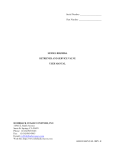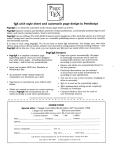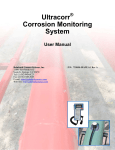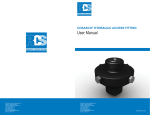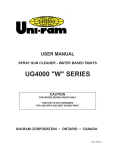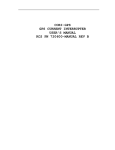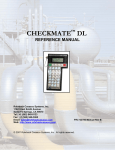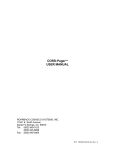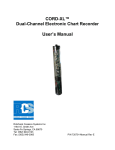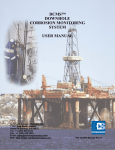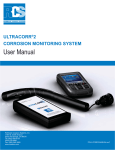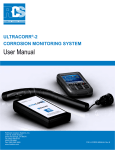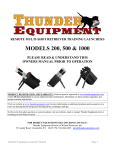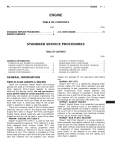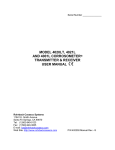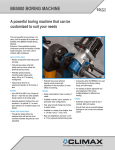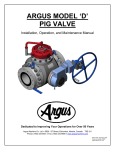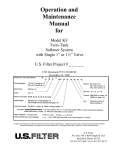Download cosasco model rsl retriever and service valve user manual
Transcript
Serial Number ___________________ Part Number ____________________ COSASCO® MODEL RSL RETRIEVER AND SERVICE VALVE USER MANUAL ROHRBACK COSASCO SYSTEMS, INC. 11841 E. Smith Avenue Santa Fe Springs, CA 90670 Phone: (1) 562-949-0123 Fax: (1) 562-949-3065 E-mail: [email protected] Web Site: http://www.rohrbackcosasco.com 600006-MANUAL REV. - i TABLE OF CONTENTS Section Contents Page 1.0 INTRODUCTION 1 2.0 SAFETY CHECKLIST 3 3.0 RETRIEVER & SERVICE VALVE CONSTRUCTION & OPERATION 5 4.0 RETRIEVAL OF SOLID OR HOLLOW PLUG ASSEMBLIES 7 5.0 INSTALLATION OF SOLID OR HOLLOW PLUG ASSEMBLIES UNDER PRESSURE 13 6.0 RETRIEVER BACK PRESSURING 17 7.0 RETRIEVER & SERVICE VALVE SPECIAL TOOLS 19 8.0 RETRIEVER MAINTENANCE 25 9.0 3600 PSI SERVICE VALVE MAINTENANCE 31 10.0 6000 PSI SERVICE VALVE MAINTENANCE 37 ii iii SECTION 1.0 INTRODUCTION The Rohrback Cosasco Systems RSL Retriever is the newest innovation from the leader in high pressure access equipment. This precision tool allows safe, easy insertion and removal of various equipment and tools through the industry-standard Rohrback Cosasco Systems Access Fitting – while the pipeline or vessel is under pressure. Used in conjunction with the Rohrback Cosasco Systems Service Valve, system pressure is safely ported into the tool which allows the valve to be opened and the retrieval operation to be performed. Rotation and translation in and out of the fitting is controlled by two adjustable handles. No movement or telescoping of the tool body is necessary and best of all, no hydraulic pumps or hoses are required. This tool can be used with the industry-standard Rohrback Cosasco Systems access fitting and service valves, with no adapters required. Each RSL Retriever Kit is furnished with service tools and spare parts in a sturdy field service box to provide compact, easy storage and portability. The new COSASCO® RSL 2500 and 6000 Retrievers utilize a compact non-telescoping design that provides the highest level of safety and the advantage of a short tool length without the inconvenience of hydraulic pumps and fluid. Best of all, it is compatible with all COSASCO® 2” High Pressure Access fittings without the need for special adapters. Access under pressure for Bottom-of-the-Line monitoring locations requires minimal clearance, avoiding the need to produce access pits or to raise the pipe work. The design without the use of sliding seals provides for easy tool maintenance and cleaning. The elimination of sliding seals reduces the cost of seal replacement. 1 2 SECTION 2.0 SAFETY CHECKLIST 1. Safe operation requires a minimum of 2 trained operators. 2. Do not use this retrieval equipment unless you have been trained in its safe operation. 3. If it has been longer than 90 days since your last operation, you should review the manual and first practice on a dummy fitting prior to use. 4. Make sure you have complied with all plant safety requirements and environmental regulations. 5. Identify the type media its pressure and temperature. Review material safety data information on the media prior to operation. 6. Insure you have all the required safety equipment for the given media, "i.e. hard hat, safety glasses, protective clothing, safety gloves, respirator, spill safety equipment, etc... 7. Any actions which could vary system pressure such as surges caused by opening and closing of valves and chokes should be delayed until completion of retrieval operations. 8. Insure you have enough clearance for safe operation. Note wind direction prior to starting operations involving hazardous products. 3 4 SECTION 3.0 RETRIEVER & SERVICE VALVE CONSTRUCTION & OPERATION RSL-2500 retrievers feature a stainless steel outer barrel, Viton o-rings, and graphite-impregnated Teflon dynamic seals. They are pressure rated to 2500 psi (172 BAR) and have a maximum operating temperature of +400BF (+204BC). RSL-6000 retrievers feature a stainless steel outer barrel, Viton o-rings, and graphite-impregnated Teflon dynamic seals. They are pressure rated to 6000 psi (414 BAR) and have a maximum operating temperature of +400BF (+204BC). On both models, a socket adapter assembly attached to the carrier assembly is used to install or retrieve the plug from the access fitting assembly. The hammer nut on the outer barrel of the retriever connects directly to the outlet side of the service valves. Two valves are available. The standard valve is rated at 3600 psi (248 BAR) and the high pressure valve is rated at 6000 psi (413 BAR). Both valves have a maximum operating temperature of 250BF. Their selection depends on the maximum working pressure required. The service valves incorporate two needle valves; the first allows slow pressurizing of the retriever, which reduces the torque required to open the service valve ball. The second allows product bleed-off through a special port, either with or without the optional diverter hose assembly. The valves comply with API Fire-Safe Standard RP6F. When the fittings are mounted at bottom-of-line they collect sand, scale or other debris. These particles can damage the threads of the access fittings, as well as the working surfaces of the retriever and service valve. Therefore, extra care and maintenance should be given to equipment used in servicing any bottom-mounted fitting. Special tools are available to aid in these situations. (See Section 7 - Retriever and Service Valve Special Tools, which describe the tools available to remove or flush sand, scale, hot tap chips or other debris from the access fitting.) If product and operating pressure permit (lower than 2500 PSI, 172 BAR), the RSL-2500 retriever with its thinner stainless steel outer barrel should be considered to reduce the weight. The retriever has eight main parts (see figure 1): 1. 2. 3. 4. 5. 6. 7. 8. Outer Barrel. Rotation Tube. Translation Tube. Socket Adapter Carrier. Socket Adapter Assembly. Head Assembly. Hammer Nut Assembly. Bleed Valve Assembly. 5 Figure 1 6 The socket adapter carrier is moved in translation and rotation by rotating the two handles on the head assembly. Rotating the outermost handle clockwise moves the carrier into the access fitting or rotating it counterclockwise moves the carrier into the retriever. Rotating the larger, inner handle clockwise rotates the carrier in the same direction as the handle. The service valve has three main parts. 1. 2. 3. The service valve body. The ball and seals. The bypass and bleed valve. The COSASCO access fitting body and plug assembly (hollow or solid) form a seal. However, the design allows the system pressure to bypass the seal when the plug assembly is "backed off" one or two turns. The bypass pressure enters the retriever through the service valve. A “normal” retrieval operation consists of the following steps. Each step will be covered in further detail in section 4. 1. Prepare the access fitting. This involves verifying the system parameters; pressure, temperature, process fluid, system surges, etc. The area must be checked for adequate clearances, safety, other personnel, etc. The protective cover and pipe plug are removed from the fitting, and the plug is loosened slightly, or “cracked”. The retriever and service valve should be checked to assure smooth operation, and proper assembly. 2. Install the service valve onto the access fitting. Insure that the valve is fully open, and the bleed and bypass valves are closed. 3. Install the retriever onto the service valve. Insure that the bleed valve on the retriever is closed. 4. Use the retriever to retrieve the plug assembly. The general steps are as follows: a. Rotate the translation handle clockwise to move the socket adapter to the top of the plug. b. Rotate the rotation handle clockwise to thread the socket adapter into the plug assembly. Slight clockwise pressure should be maintained on the translation handle to move the carrier forward as the thread engages the plug assembly, but not so much pressure that the hex on the socket adapter drops over the plug assembly. Thread the socket adapter into the plug assembly about 4 or 5 turns. c. Rotate the translation handle clockwise to drop the hex over the plug assembly. The rotation handle will need to be turned slightly during this operation in order to line up the hex with the plug. You will know when it is aligned and dropped onto the plug when the translation handle can advance about 90°. Also, the rotation handle will be difficult to turn when the hex is dropped over the fitting. d. While maintaining slight clockwise pressure on the translation handle (to assure the socket adapter hex stays dropped over the plug assembly), rotate the rotation handle counterclockwise slowly. System pressure should enter the retriever (as seen on the pressure gage on the bleed valve assembly) after 1 to 2 turns. Once pressure is stabilized, 7 continue to turn the rotation handle counter clockwise to completely remove the plug from the fitting. This normally takes about 14 rotations, and you will often hear and/or feel a ‘click’ sound once each rotation once the plug is out of the fitting. e. Rotate the translation handle counterclockwise to pull the plug assembly into the retriever tool. If the translation handle only rotates about 90° and then stops, then the plug assembly is not fully unthreaded from the access fitting. Return to step ‘d.’ and continue to unthread the plug. If it rotates freely, then the plug is unthreaded and you will continue rotating counterclockwise until it stops when the socket adapter carrier has reached the top of the retrieval tool. f. Slowly close the service valve, making sure there is no obstruction in the valve. Once fully closed, bleed off pressure from the retrieval tool, using either the bleed valve on the retriever or the service valve, or both. Verify pressure has been completely bled using the pressure gage on the retrieval tool. g. Remove the retriever from the service valve. Once removed, you can rotate the translation handle clockwise to move the plug assembly out of the front of the tool for removal. 5. To install a new device into the system, the following general steps are used. These steps will be covered in greater detail in section 5. a. Insure that the service valve is installed on the fitting, and that the valve, as well as the bleed and bypass valves are closed. b. Install the new device onto the socket adapter assembly, at least 4 to 5 turns. Rotate the translation counterclockwise until it stops to fully retract the new device into the retriever tool. c. Install the retriever onto the service valve. Insure that the bleed valve on the retriever is closed. d. Slowly open the bypass valve on the service valve. Verify full system pressure on the pressure gage on the retriever. e. Slowly open the service valve. Insure the valve is open completely. f. Rotate the translation handle clockwise until it stops. While maintaining clockwise pressure on the translation handle, rotate the rotation handle clockwise to thread the plug assembly into the access fitting body. Maintain clockwise pressure on the translation handle to insure that the socket adapter hex remains over the plug assembly. The plug assembly requires approximately 14 turns to fully seat into the access fitting body. g. Rotate the translation handle counterclockwise to back the hex off of the access fitting body. The translation handle should move about 90° counterclockwise. Rotate the rotation handle counterclockwise a minimum of 5 turns to unthread the socket adapter assembly from the plug assembly. If the hex is properly backed off of the plug assembly, the rotation handle will rotate fairly easily. If it is difficult to rotate, then make sure the 8 translation handle is rotated counterclockwise as far as it will go. h. Rotate the translation handle counterclockwise to move the socket adapter away from the plug assembly. Bleed the pressure from the tool using the bleed valve on the retriever, the bleed valve on the service valve, or both. Insure that the pressure is reduced to zero on the pressure gage on the retriever. i. The retriever and service valve may now be removed from the access fitting. Replace the pipe plug and protective cover on the access fitting body. 9 10 SECTION 4.0 RETRIEVAL OF SOLID OR HOLLOW PLUG ASSEMBLIES The following procedure is for retrieval of solid or hollow plugs from access fitting bodies under pressure. The operator should first determine pressure, temperature, and the type of media. Any action which could vary pressure, such as surges caused by the opening or closing of valves or chokes, should be delayed until after the retrieving operation has been completed. 1. Stroke and circumferential clearance. Determine if the retriever has an adequate stroke clearance and that the entire operation has adequate circumferential clearance. a. Clearance beyond the top of the access fitting body is required for installation and operation of the retriever and service valve. The following recommendations should give adequate clearance: 18" stroke 25" stroke 37" stroke b. - 4 feet (1.2 meters) 5 feet (1.5 meters) 6 feet (1.8 meters) In addition, circumferential to allow movement of the operator(s) and free movement of the equipment is required. The following recommendations should give adequate clearance: Above ground level - From the center-line of the access fitting, a radius of at least three feet should be maintained. Below ground level - A minimum diameter culvert of manhole of four feet should be provided; with the fitting placed off-center one foot from the culvert wall. Note that both the translation handles and rotation handles are adjustable in radius to allow use in close radial proximity to other objects. However, using the handles in this way will result in slower operation of the tool. 2. Adjust the socket adapter assembly. For solid or hollow plug assemblies, the socket adapter should be set in the second and fourth holes from the hex end. When retrieving the hot tap plug assembly with the 14" or 18" stroke retriever, the socket adapter must be in the first and third holes from the hex end. 3. Remove the access fitting cover, if present. After removing the cover, check the access fitting body to ensure that the o-ring contact area is clean and that the acme thread is in good condition. 11 If the thread has been painted or damaged, it should be repaired by brushing or filing. The use of the optional heavy protective cover manufactured of steel is recommended, since it is more durable. 4. Loosen the plug assembly. It is recommended that, prior to removing either the plastic or steel pipe plug, the plug assembly be unfrozen from its seat. Using either a 1-1/8" socket or a 1-1/8” box-end wrench, loosen the plug assembly by turning counterclockwise to a maximum of 1/4 turn. DO NOT loosen beyond the 1/4 turn maximum or leakage may result. If leakage begins, tighten the plug as required to stop the leakage. 5. Remove the pipe plug from the plug assembly. The solid plug assembly uses a stainless steel pipe plug with a 1/2" square head which acts as a secondary seal. Hold the plug assembly hex with a box-end wrench to prevent it from backing off while using a crescent wrench to turn the pipe plug slightly counterclockwise. If, for any reason, there is pressure behind the plug which, after one or two minutes, has not been bled-off, loosen the steel pipe plug 1/8 turn more. If pressure bleeds-off, remove the pipe plug; if it has not, re-tighten the pipe plug and refer to Section 7 -Retriever and Service Valve Special Tools, Section 7.4. The hollow plug assembly uses a plastic pipe plug as a dust cover only; therefore, no bleed-off will be required. 6. Check the service valve. Inspect the o-ring at the hammer nut end for nicks, cuts and abrading. It is recommended to inspect and pressure test the service valve periodically to be sure it is in good working order, as there is a possibility that, should a problem occur, it will have to be left on the line. 7. Connect the service valve to the fitting. Lift the service valve assembly and place it on the access fitting body. Thread the hammer nut clockwise until the service valve is securely seated. 8. Tap the hammer nut tight using a brass hammer. WEAR SAFETY GLASSES! Close and open the service valve ball to be sure there is adequate handle clearance. If there is not, loosen and reposition the handle until adequate clearance is obtained. The valve should be left in the open position. 12 9. Check the retriever. Inspect the thread adapter o-ring for nicks, cuts and abrading. a. Operate the retriever. Operate the translation handle and rotation handles, and check that they operate smoothly, without binding or excessive noise. 10. To connect retriever. Lift the retriever and place it on the service valve. Turn the hammer nut clockwise until the retriever is seated on the service valve. 11. Tap the hammer nut tight. Using a brass hammer - WEAR SAFETY GLASSES! 12. Connect the socket adapter pilot. Rotate the translation handle clockwise to move the socket adapter to the top of the plug. Once at the top of the plug, rotate the rotation handle clockwise to thread the socket adapter into the plug assembly. Slight clockwise pressure should be maintained on the translation handle to move the carrier forward as the thread engages the plug assembly, but not so much pressure that the hex on the socket adapter drops over the plug assembly. This operation is a little tricky at first, but is fairly simple once the concept is understood and practiced a few times. While rotating the rotation handle, maintain enough clockwise pressure on the translation handle to allow the pilot adapter to thread into the top of the plug assembly, but not so much pressure that the hex socket drops over the plug assembly. If the rotation handle becomes difficult to turn, rotate the translation handle slightly clockwise. If the rotation handle becomes easy to turn, then continue threading it into the plug. If it remains difficult, then the hex has probably engaged the plug, at which point you must rotate the translation handle counterclockwise to disengage the hex, and then continue clockwise with the rotation handle. Once properly engaged to the plug, thread the socket adapter into the plug assembly about 4 or 5 turns. 13. Close bleed valves. Ensure that both the retriever and service bleed valves are closed. 14. Connect the socket adapter hex. Rotate the translation handle clockwise to drop the hex over the plug assembly. The rotation handle will need to be turned slightly during this operation in order to line up the hex with the plug. You will know when it is aligned and dropped onto the plug when the translation handle can advance about 90°. Also, the rotation handle will be difficult to turn when the hex is dropped over the fitting. You may need to rotate the rotation handle in either a clockwise or counter clockwise direction, while maintaining clockwise pressure on the translation handle, until you feel the hex drop onto the plug assembly. This is the one other operation which can be easily mastered with a few practice sessions. 13 15. Retriever "pressure balancing". Although this tool does not ‘telescope’ and introducing pressure into the tool does not present any unusual safety hazard, it is good practice, and safest, to introduce pressure into the tool slowly, and avoid any sudden pressure changes or surges. 16. a. While maintaining clockwise pressure on the translation handle, to assure the hex stays firmly over the plug assembly, turn the rotation handle slowly counterclockwise, to unseat and begin backing off the plug assembly. b. Retriever pressurization will begin after 1/2 to 2 turns of the rotation handle. Pressurization will be signified by one of three means; gauge, hearing the fluid enter the retriever, or feeling the increase in friction as the seals experience pressure load. When the retriever begins to pressurize, stop turning the rotation handle and wait for the retriever to equalize pressure. This is achieved only when the entire retriever and the operating line are at equal pressure. c. If the retriever fails to pressurize after 2 turns, back-off the plug assembly by an additional 2 counterclockwise turns of the rotation handle. If the retriever still has not balanced, wait for 10 to 15 minutes. DO NOT BACK-OFF THE PLUG ASSEMBLY MORE THAN A TOTAL OF 4 TURNS! d. The retriever bleed valve can be opened to test for the presence of pressure in the retriever. If after waiting the required 10 to 15 minutes, the pressure has not entered the retriever, the plug assembly or the retriever has encountered an obstruction or accumulation of dirt or debris. Back pressuring the retriever should be the next step for relieving the obstruction. See Section 6 - Retriever Back Pressuring. Retrieving the plug assembly from the access fitting body. a. When the retriever has "pressure-equalized" with the line, the plug assembly can be disengaged from the access fitting body. b. Turn the rotation handle counterclockwise approximately 15 or 16 turns to completely disengage the plug assembly from the access fitting body. c. Ensure that the socket adapter hex and the plug assembly hex remain engaged during this operation, by maintaining clockwise pressure on the translation handle. Disengagement will allow the socket adapter pilot to unscrew from the plug assembly, leaving the plug assembly in the access fitting body. (Refer to paragraphs 12 and 14). 17. After the plug assembly is removed - from the access fitting body, rotate the translation handle counterclockwise to draw the plug assembly completely into the retriever tool. If the translation handle stops after about ¼ of a turn, then the plug assembly is not completely removed from the access fitting body. In this case, drop the hex back over the plug assembly (see paragraph 14) and continue to unthread the plug assembly until it is completely withdrawn from the access fitting body. 18. Close the service valve equalizing valve and the service valve ball. 14 a. Close the service valve equalizing valve. The service valve extension handle features a slotted end to engage the roll pin of the equalizing valve stem for easy opening and closing. b. 19. Close the service valve ball using the service valve extension handle. Bleed-off retriever pressure. The retriever is still fully pressurized at this stage, and this pressure must be fully relieved. An optional diverter hose assembly is recommended when bleeding off retriever pressure; fluids can be collected in a container or diverted to a safe area away from the operator. The hose is attached by quick-connect to either the retriever bleed valve or the open port in the service valve. Optional diverter hose assemblies are: 124669 diverter hose assy. 10 ft (3.0 m) 124931 diverter hose assy. 25 ft (7.6 m) 124685 diverter hose assy. 50 ft (15.2 m) Bleed the pressure from the retriever by opening the retriever bleed valve one or two turns for gas or liquid on bottom or side position. For top locations, remove the service valve port plug and then open the service valve bleed valve one or two turns. Watch the pressure gauge; a gradual drop to zero should be indicated, at which point the retriever should have bled-off pressure completely. This may take up to two minutes to complete. 20. Close the bleed valve. When the retriever is completely depressurized, disconnect the diverter hose assembly and close the bleed valve. 21. WEAR SAFETY GLASSES! Tap loose the retriever hammer nut using the brass hammer. It may be advisable for two men to help each other in removing the retriever from the fitting. 22. Lift the retriever to remove from the service valve. Do this carefully. If the product media is liquid, a certain amount will ooze at the disconnect junction or from the retriever. 23. Check retriever operation. Operate the retriever rotation and translation handles. If it seems difficult to operate, or feels or sounds gritty; cleaning and lubricating before further use is recommended. 15 16 SECTION 5.0 INSTALLATION OF SOLID OR HOLLOW PLUG ASSEMBLIES UNDER PRESSURE The following procedure assumes the service valve is installed on the access fitting body and is in the closed position. The retriever must be in a cleaned and lubricated condition. 5.1 Prepare the plug assembly. a. Visually inspect the plug assembly threads and clean or repair, if necessary. Minor repairs can be done by using thread files; or for more severe damage, the thread die assembly (part number 125112 can be used). A spare access fitting body can be used to check for fit. b. Replace all o-rings and packings. If the plug assembly was previously used, it is recommended that the seals be replaced. c. Connect the corrosion monitoring or preventing device to the plug assembly. After initial packing contact, compress the packing by tightening the device up to 1/4 turn more. Securely lock into place by tightening the set screw. d. Index the plug assembly hex. If the corrosion monitoring or preventing device requires orienting with the product flow, "index" the plug assembly by filing a notch across the top of the hex. The notch should be filed so that the device can be aligned with the product flow. 5.2 Clean the fitting threads if required. Thread condition can be assessed by the ease of the removal procedure. If repair and/or cleaning appear necessary, see Section 7 - Retriever and Service Valve Special Tools. 5.3 Connect the plug assembly to socket adapter pilot. Engage the plug assembly female threads to the socket adapter pilot male threads. Do not bottom the plug assembly on the socket adapter pilot, but allow approximately 1/4 turn back-off from full engagement (the o-ring on the socket adapter pilot should provide the proper spacing when hand tight). Align the hex on the plug assembly with the hex on the socket adapter to ensure they will engage. 5.4 Rotate - the translation handle counterclockwise to draw the plug assembly into the retriever. 5.5 Connect the retriever to the service valve. First, examine the o-ring at the hammer nut end of the retriever for damage and replace if nicked, cut or abraded. Lift the retriever and place it on the service valve. Turn the hammer nut clockwise until the retriever is securely seated on the service valve. Use the brass hammer to tap a secure connection. WEAR SAFETY GLASSES! 5.6 Ensure that the bleed valves are fully closed - on both the retriever and service valve. 17 5.7 Slowly open the service valve equalizing valve to pressurize the retriever. Before proceeding further, wait until the retriever is fully pressurized. 5.8 Open the service valve ball and close the equalizing valve. 5.9 Rotate the translation handle clockwise until it stops. At this point, the plug assembly is resting on the top of the access fitting body. 5.10 Engage the plug assembly to the access fitting body. a. While maintaining clockwise pressure on the translation handle, rotate the rotation handle clockwise to thread the plug assembly into the access fitting body. Maintain clockwise pressure on the translation handle to insure that the socket adapter hex remains over the plug assembly. If the plug assembly does not start threading properly, turn the rotation handle counterclockwise one full turn, then clockwise again to engage the threads. Do not use excessive force and be sure that the threads engage properly to prevent cross threading. b. If cross threading does occur, the plug assembly will have to be removed observing all of the procedures as outlined in Section 4 - Retrieval of Solid or Hollow Plug Assemblies under Pressure. Also, see Section 7 - Retriever and Service Valve Special Tools Tap Assembly #125116. 5.11 To complete the engagement - of the plug assembly to the access fitting body, turn the rotation handle 14 or 15 turns. The plug assembly should be barely or lightly seated. Tighten only 1/4 turn after the primary packing contacts its seat within the access fitting body. This will leave sufficient room for travel for orientation using the index mark mentioned previously. 5.12 If the plug assembly does not seat properly, it may be caused by one of the following: a. Damaged plug assembly thread. Remove and repair with thread die assembly #125112 or replace the plug assembly. b. Damaged access fitting body thread. The use of thread tap assembly (part number 125111) is recommended. c. Sand or chips in the threads. Use the thread brush assembly #125116, surge tube assembly #123672 or the magnetic swab assembly #121870. d. Monitoring or preventing device hitting the bottom of the pipe. This will require replacement with a shorter device. e. Monitoring or preventing device hitting an obstruction at the access fitting body base. This may be due to improper weld procedures or noncentricity of access fitting body with the cut or hot tapped hole into the pipe. This condition will require the reaming of the hole into the pipe with a hot tap square end mill (part number 612016-7.12). f. Incorrect access fitting body weld procedures. This can cause body distortion or warpage due to excessive heat or improper after-weld stress relieving. If distortion or warpage appears minor, the use of access fitting body seat reamer #125125 is recommended. If distortion or warpage is major, a new access fitting body should be 18 welded to the line using the proper welding procedures. See Manual 740074 Trepanning, Positioning and Welding Procedures. Indications of any of the above causes will be noted after retriever bleed-off is accomplished as described in paragraph 13. The indications may be an unstable pressure gauge reading, the hearing of pressure still entering the retriever, or feeling the lack of pressure load on the seals as evidenced by a lack of friction. If the plug assembly cannot be seated and sealed, it may be necessary to leave the service valve on the line until a later shut-down when repairs can be made. If this becomes necessary, a service valve blanking plug #127391 should be placed on the service valve after the retriever has been removed to prevent possible leaks or inadvertent opening of the service valve. 5.13 Retriever bleed-off. Open the bleed valve and drain the retriever product pressure and media residue into a container or safe area until all pressure has been relieved. 5.14 Disengage the socket adapter from the plug assembly. Disconnect the diverter hose assembly, if it was used. Rotate the translation handle counterclockwise to back the hex off of the access fitting body. The translation handle should move about 90° counterclockwise. Rotate the rotation handle counterclockwise a minimum of 5 turns to unthread the socket adapter assembly from the plug assembly. If the hex is properly backed off of the plug assembly, the rotation handle will rotate fairly easily. If it is difficult to rotate, then make sure the translation handle is rotated counterclockwise as far as it will go. 5.15 Loosen the retriever hammer nut and remove the retriever. Using the brass hammer, tap loose the hammer nut and unscrew fully. WEAR SAFETY GLASSES! Lift the retriever from the service valve ... do this carefully if the product media is a liquid because a small amount of product will be lost at the disconnect junction. 5.16 Install the stainless steel pipe plug. Liberally grease 1/2" stainless steel pipe plug and install securely into the solid plug assembly. NOTE: Hollow plug assemblies use a red plastic pipe plug; therefore, greasing is unnecessary. 5.17 Orient the plug assembly. The index mark filed as mentioned in paragraph 5.1.d must now be aligned to the product flow direction. Turn the plug assembly hex clockwise until the mark aligns with the flow direction. If the plug assembly was installed as described, sufficient room for travel to allow orienting will be available. CAUTION: DO NOT TURN THE PLUG ASSEMBLY HEX COUNTERCLOCKWISE TO ACHIEVE ORIENTATION! 5.18 Prior to installing the protective cover - thoroughly grease the acme threads on the access fitting body. This measure will save many hours of cleaning when the access fitting is next serviced. 19 20 SECTION 6.0 RETRIEVER BACK PRESSURING Back pressuring is the pressurizing of the retriever from an external source through the retriever bleed valve. This procedure may be necessary when the plug assembly will not allow line pressure to bleed past it within the access fitting body or removing fittings at high pressures with the RSL retriever. Several means of back pressuring may be used: a. b. c. Nitrogen bottle. Hydraulic (Part No. 203855) or pneumatic pump. An adjacent tee access fitting (utilizing its line pressure). The nitrogen bottle method is the procedure described. The procedure assumes that the retriever and service valve are connected to the access fitting body. 6.1 Connect a high pressure hose to the retriever bleed valve. 6.2 Nitrogen bottle connection. Connect the other end of the high pressure hose to the nitrogen bottle outlet. It is recommended that: a. The nitrogen bottle pressure be at least 200 psi (13 BAR) higher than the line pressure. b. The nitrogen bottle be equipped with a regulator. c. The nitrogen bottle be fitted with a bleed valve. (This is desirable to allow bleeding down the hose after back pressuring is completed). 6.3 Nitrogen bottle control valve. Open the control valve and allow pressure build-up within the hose to 100 psi (6 BAR) above the line pressure. 6.4 Open the retriever bleed valve - and allow the nitrogen pressure to enter the retriever. Normally, the pressure will come to a balance and the excess pressure will enter the operating line. A back pressure or pressure flow reverse will have been accomplished. In doing so, debris, contaminants or other obstructions within the retriever, service valve, plug assembly or access fitting body will be dislodged to enter the product stream flow. 6.5 Close the retriever bleed valve. 6.6 Close the nitrogen bottle control valve. Bleed off the pressure within the hose and disconnect it from the retriever bleed valve. 6.7 Remove the plug assembly - in the normal manner and as previously described in Section III. 21 22 SECTION 7.0 RETRIEVER & SERVICE VALVE SPECIAL TOOLS When using the service tools described within this section, it is advisable to use the shortest stroke, and consequently the lightest, retriever available. Besides easier handling, it will provide the best "feel" when using the special tools. The following procedures assume that the service valve is installed on the access fitting body and that it is in the closed position. The plug assembly is also assumed to be absent from the access fitting body. 7.1 Thread Tap Assembly #125111. The thread tap assembly is used to clean debris from threads or to repair thread damage. 1. Attach and grease the tap. Attach the tool to the socket adapter pilot male thread. Apply grease liberally to the cutting edges. 2. Lift the retriever and place it on the service valve. Turn the hammer nut clockwise until the retriever is securely seated and tightened in place on the service valve. Use the brass hammer to make up a secure connection. WEAR SAFETY GLASSES! 3. Open the service valve equalizing screw and then open the service valve ball. 4. Rotate the translation handle clockwise until the tap just contacts the top of the access fitting body. 5. Turn the rotation handle two full turns counterclockwise. This will help to allow the tap threads to align with the access fitting body threads. 6. For thread tap cutting, slowly turn the rotation handle clockwise allowing the tool threads to engage the access fitting body threads. Continue turning the rotation handle clockwise 14 to 17 turns, while maintaining slight clockwise pressure on the translation handle; occasionally, turn the rotation handle counterclockwise to help the tap threads to clear. Do not allow the tap to bottom. 7. When the tap operation is completed, connect the diverter hose assembly to the retriever bleed valve. Open the retriever bleed valve and allow bleed-off for approximately twenty seconds. Normally this is sufficient time for debris to be flushed from the access fitting body threads. 23 7.2 8. Close the retriever bleed valve. Remove the diverter hose assembly. 9. Retrieve the tap. Turn the rotation handle counterclockwise for about 14 to 17 turns, while maintaining slight counterclockwise pressure on the translation handle, until the tap threads are fully disengaged from the access fitting body threads. 10. Once the tap is clear of the threads, rotate the translation handle counterclockwise until it stops, to draw the tap into the retriever 11. Close the service valve ball and the service valve bleed screw. 12. Bleed and remove the retriever. Open the retriever bleed valve and allow pressure to bleed off completely. Using the brass hammer, tap loose and fully unscrew the retriever hammer nut. WEAR SAFETY GLASSES! Lift the retriever from the service valve. 13. Remove the tap. Unscrew the tap from the socket adapter pilot. (NOTE: If the tool flutes have a large amount of debris, it is recommended that the surge tube assembly or thread brush assembly be used to clean the access fitting body and threads prior to reinstalling the plug assembly. See part 7.3 and/or 7.2 following.) Thread Brush Assembly #125116. The thread brush assembly is used to clean small amounts of debris from the access fitting body threads. 1. Attach the thread brush assembly to the socket adapter pilot threads. 2. Connect the retriever. Lift the retriever and place it onto the service valve. Turn the hammer nut clockwise until the retriever is securely seated on the service valve. Use the brass hammer to tap a secure connection. WEAR SAFETY GLASSES! 3. Open the service valve equalizing valve and then open the service valve ball. 4. Rotate the translation handle clockwise until the thread brush just barely contacts the access fitting body. 5. Brush the threads. Turn the rotation handle in both directions while turning the translation handle clockwise, until it bottoms. 6. Retrieve the thread brush assembly. Beginning with a very slight clockwise rotation on the rotation handle, pull the brush straight up and out of the access fitting body by rotating the translation handle counterclockwise. 24 7.3 7. Pull the thread brush into the retriever by rotating the translation handle counterclockwise until it stops. 8. Close the service valve and the service valve equalizing valve. 9. Bleed and remove the retriever. Open the retriever bleed valve and allow pressure to bleed off completely. Using the brass hammer, tap loose and fully unscrew the retriever hammer nut. WEAR SAFETY GLASSES! Lift the retriever from the service valve. 10. Remove the thread brush assembly. Unscrew the thread brush assembly from the socket adapter pilot. Surge Tube Assembly #123672. The surge tube assembly is used to flush debris from the access fitting body by using line pressure. 1. Connect the surge tube assembly. Life the surge tube assembly and place the hammer nut end on the service valve. Turn the hammer nut clockwise until the surge tube assembly is securely seated. Use the brass hammer to tap a secure connection. WEAR SAFETY GLASSES! 2. Close the surge tube bleed valve. The same optional diverter hose assemblies used on the retriever and service valve are available for connection to the surge tube assembly. 3. For LOW PRESSURE lines: (pressures lower than 250 psi -17 BAR), see (L) steps below. For HIGH PRESSURE lines: (pressures higher than 250 psi -17 BAR), see (H) steps below. 4L. Open the service valve quickly. 5L. Open the surge tube bleed valve and allow flow for approximately twenty seconds. 6L. Close the surge tube bleed valve. 7L. Close the service valve. 8L. Open the surge tube bleed valve and allow the surge tube pressure to bleed off. 9L. Close the surge tube valve. 10L. Repeat steps 4L through 9L at least two more times. 25 4H. Open the service valve equalizing valve. This will reduce the torque required to open the service valve. 5H. Open the service valve quickly and then close the service valve equalizing valve. 6H. Open the surge tube bleed valve and allow flow for approximately twenty seconds. 7H. Close and open the surge tube bleed valve - at least two more times and each time allow flow for approximately twenty seconds. Each time the surge tube valve is in the open position, partially close and then fully open the service valve. This will help to remove solids or particles from the seat area or carrier. 8H. Close all valves. Close the surge tube bleed valve, the service valve and the service valve equalizing valve. 9H. Open the surge tube bleed valve and allow the surge tube pressure to bleed-off. 10H. Close the surge tube bleed valve. If the optional diverter hose assembly is being used during the operation, it should be removed at this time. 11. 7.4 Remove the surge tube assembly. Using the brass hammer, tap loose and fully unscrew the surge tube hammer nut. WEAR SAFETY GLASSES! Lift the surge tube assembly from the service valve. Steel Pipe Plug Adapter #125115. The steel pipe plug adapter is used to install or allow retrieval of the 1/2" steel pipe plug, while plug assemblies are under pressure. This tool is used in cases where bleed-off cannot be accomplished. The procedure described for the steel pipe plug adapter differs from the other tools described in this section in that the service valve is assumed not to be installed and that the plug assembly is assumed to be present within the access fitting body. 1. Attach the pipe plug adapter to the square head of the pipe plug and tighten the Allen head set screws. 2. Install the service valve onto the access fitting body in the same manner as described previously in Section 4, paragraphs 6, 7, and 8. Open the service valve ball. 3. Install the retriever and engage the socket adapter in the same manner as described previously in Section 4, paragraphs 8 through 14. 26 4. Pressure equalize the retriever in the same manner as described previously in Section 4, paragraph 15. After pressure equalization is achieved, slowly turn the rotation handle in a counterclockwise direction, thus loosening the pipe plug. 5. Retrieve the pipe plug. Continue to turn the rotation handle in a counterclockwise direction until the pipe plug is disengaged from the pipe plug assembly; then draw the pipe plug into the retriever by rotating the translation handle counterclockwise. 6. Close the service valve. 7. Open the bleed valve and bleed off pressure. 8. Using the brass hammer tap loose the retriever hammer nut and unscrew fully. WEAR SAFETY GLASSES! Lift the retriever from the service valve. 9. Rotate the translation handle clockwise to expose the socket adapter, the attached pipe plug adapter and the pipe plug. Remove the adapter and the pipe plug from the socket adapter pilot. 10. Reinstall the retriever on the service valve and remove the solid plug assembly in the same manner as described previously in Section 4, paragraph 9 to 23. 27 28 SECTION 8.0 RETRIEVER MAINTENANCE The maintenance interval required by the RSL retriever will vary depending upon the service to which it is subjected. Certain fluids will wash out all lubricant from the retriever after one retrieval; others can deposit debris in the retriever making operation difficult. There are three levels of maintenance required. The level of maintenance required, and the frequency required will vary depending on the frequency of use, process conditions, anticipated length of storage, and condition of the retriever. 1. Flush and Lubricate – This level does not require any disassembly of the retriever. It consists of repeated filling and flushing of the tool with a suitable lubricant. If in a days operation (because of adverse retrieval environment conditions) the retriever becomes difficult to operate, feels gritty and does not stroke or turn easily, it should first be cleaned and lubricated without disassembly as indicated in Part 8.2 below. If cleaning and lubricating without disassembly does not relieve the difficulties in the retriever operation, it should be completely disassembled, cleaned and lubricated as indicated in either Part 8.3 or 8.4 of this Section. 2. Disassembly and Cleaning – This level requires simple disassembly of the hammer nut assembly and the head assembly. This will allow removal of the translation tube, rotation tube, and socket adapter and carrier, for cleaning and lubricating. If the retriever has been in use and it is anticipated not being used again for a period longer than one day, it should be completely disassembled, cleaned and lubricated. 3. Overhaul and Seal Replacement – This level requires an overhaul of the head assembly. If operation of the rotation or translation handles becomes difficult, or feels gritty after cleaning the tool as described in paragraph 2, or there is any leakage from the head assembly, then overhaul and replacement of the seals should be performed as indicated in Part 8.4 of this section. Lubricant choices are many. For a particular service, some experimentation may be necessary. Recommended lubricants are: 8.1 1. Motor Oil - (SAE 30 weight or equivalent). 2. Lubriplate (multi-purpose) - A lithium base grease; usually the best choice for most service since it is thin and applies easily. Use for service temperatures of 0B to +350BF (-18B to +177BC). Available as COSASCO 129372. 3. Synthetic lubricant - A molybdenum disulfide grease containing rust and oxidation inhibitors. It is recommended for use in extreme pressures and temperatures (-40B to +600BF, -40B to +316BC). Available as COSASCO 201688. Sour Gas Service. On the model RSL retriever, applicable materials comply with the requirements of NACE standard MR0175, "Sulfide Stress Cracking Resistant Metallic Materials for Oil Field 29 Equipment." As stated in this standard. "Materials ... are resistant to, but not necessarily immune to (sulfide stress cracking) under all service conditions." Thus, when the retriever is used in sour environments, it must be thoroughly cleaned after use to help prevent corrosion and/or damage to internal materials. 8.2 8.3 Flush and Lubricate without Disassembly. 1. Operate the translation handle so that the socket adapter is withdrawn about half way into the too. Place the retriever head end down on a clean surface. 2. Add solvent. Pour approximately one pint (1/2 liter) of solvent into the retriever inner barrel. 3. Turn the retriever to a 45° angle, and rotate the entire tool slowly. 4. While holding the retriever at an angle, slowly rotate the translation and rotation handles about one full turn in each direction. 5. Turn the retriever end-for-end. With the retriever head end up, let the solvent drain out. 6. Repeat steps 1 through 5. 7. The retriever head end should again be placed down on a clean surface. 8. Pour SAE 30 weight motor oil into the retriever barrel (a minimum of four ounces 100 grams). 9. Turn the retriever to a 45° angle. 10. Operate the rotation and translation handles to coat the surfaces with oil. Turn the retriever end-for-end to drain the oil. 11. Test the retriever operation. If the retriever still has a gritty feel and sound after this cleaning procedure, it must be disassembled for thorough cleaning and lubricating. Retriever Disassembly and Cleaning (See Figure 2). 30 Figure 2 1. Loosen and remove two set screws (1), which are located on the Outer Barrel (7), near the Hammer Nut, using a 3/16” Allen Wrench. 2. Loosen and remove the Hammer Nut assembly (2), using the Spanner Wrench provided. Inspect the O-ring on the inboard end of the Hammer Nut assembly and replace, if required. 3. Carefully slide the Socket Adapter Assembly (3), the Rotation Tube (4), and the Translation Tube (5) out of the Outer Barrel (7). Take care to preserve the Lower Spacer, which is located between the Translation Tube (5) and the Rotation Tube (4). 4. Remove the Drive Pin (6), which is protruding from the slot in the Rotation Tube (4). This will allow the Socket Adapter Assembly to be removed from inside the Translation Tube (4). 5. Loosen and remove two set screws (1), which are located on the Outer Barrel (7), near the Bleed Valve Assembly, using a 3/16” Allen Wrench. 6. Loosen and remove the Head Assembly (8), using the large jaw Monkey Wrench provided. 7. Clean all parts using a suitable solvent. Flush out any debris from the Head Assembly (8). The Head Assembly will not need to be disassembled as long as it is operation 31 smoothly, without any grinding feel, and is not leaking. See section 8.4 if the Head Assembly needs to be overhauled. 8. Apply grease (Dow #44 Bearing Grease is provided) to all moving parts, and the O-ring on the Hammer Nut Assembly (2). 9. Thread the Head Assembly (8) onto the end of the Outer Barrel (7). Tighten to approximately 20 ft-lbs, using the large jaw Monkey Wrench. Do not over-tighten the Head Assembly. Install the two Set Screws (1) and torque to approximately 100 in-lbs. 10. Slide the Translation Tube (5) into the Rotation Tube (4) so that the ends are flush with each other. Slide the Socket Adapter assembly (3) into the Translation Tube , so that the hole in the top of the Socket Adapter Assembly lines up with both the spiral slot in the Translation Tube, and the longitudinal slot in the Rotation Tube. Drop the Drive Pin (6) into the hole in the Socket Adapter Assembly. 11. Carefully slide the completed tube assembly into the Outer Barrel (7). Once the tube assembly is fully inserted, stand the retriever head end down. Carefully rotate the Translation Tube (5) and the Rotation Tube (4), until they line up with the head assembly drive shafts. You will feel them drop into place, and they will only rotate if the appropriate drive shaft on the head assembly is rotated. 12. Insert the Lower Spacer into the Outer Barrel (7). The protruding flange on the Spacer must be positioned between the Translation Tube (5) and the Rotation Tube (4). 13. Thread the Hammer Nut Assembly (2) into the Outer Barrel (7). Tighten with the Spanner Wrench to approximately 20 ft-lbs. Do not over-tighten this connection. Install and torque the two Set-Screws (1) to approximately 100 in-lbs. 14. Check the tool for proper operation. Rotate the Translation handle, and the Rotation handle, and assure the Socket Adapter moves in and out with no binding. Pressure test the tool using a non-corrosive liquid, such as motor oil. Rated working pressure is 2500 psi (17.2 MPa) for the model RSL-2500, or 6000 psi ((41.3 MPa) for the model RSL6000 retriever. Note that the pressure rating for the retriever is engraved on the outer barrel of the tool. 8.4 Retriever Overhaul and Seal Replacement (see Figure 3). If the Rotation handle or the Translation handle do not operate smoothly, or you feel any grinding and/or notice any pressure leaks, the Head Assembly should be overhauled and the seals replaced. 32 Figure 3 1. Disassemble the tool per section 8.3, paragraphs 1 – 6. 2. Using the Drive Punch provided, drive out the Roll Pin (20) from the Socket Drive (8). Remove the Socket Drive(8) from the Translation Shaft (4). Set aside the Translation Shaft Thrust Washer (7). 3. Loosen the Set Screw holding the Drive Ring (16), and remove the Drive Ring (16) from the Translation Shaft (4). Set aside the Rotation Shaft Thrust Washer (19). 4. All remaining items may now be separated from each other. All parts will separate without use of tools; however, due to the close tolerances and lubrication, some items may be difficult to separate. Generally, using the mating part in the opposite direction will provide enough force to remove the part. 5. The two seal carriers will still have the seals attached. Both carriers hold the high pressure dynamic seal on the inside, and a static O-ring on the outside. Use a small flat blade screwdriver to remove the seals and O-rings, using care not to damage the surface of the carrier. Discard the seals. 6. Thoroughly clean all parts in a suitable solvent. 7. Install new seals and O-rings in the seal carriers. Note that the opening on the high pressure seals must face the nearest opening in the seal carrier (see figure 4). Carefully roll the seal into the groove until it snaps into place. 33 Figure 4 8. Lubricate the seals and O-rings with a suitable grease, such as Dow #44 (supplied). Also, generously pack both bearings with grease. Coat all inner surfaces with grease. 9. Reassemble the cap assembly. Refer to figure 3 for orientation. Start with the Translation Shaft (4), and assemble as follows: a. Slide the assembled Translation Seal Carrier Assembly (5)(9)(10) onto the Translation Shaft (4). The “cup end” of the seal goes on the shaft first. Gently roll the seal onto the shaft, using care not to damage the lip of the seal. Once on the shaft, slide all the way forward. b. Slide the Seal Back-up Ring (6) behind the Seal Carrier (5). c. Slide the Translation Bearing Assembly (2) behind the Seal Back-up Ring (6). NOTE: The bearing race with the smaller inner diameter goes on the shaft first. d. Slide the Rotation Shaft (1) over the Translation Shaft assembly. Push it down until the O-ring seats on the inner surface of the Rotation Shaft, and the Rotation Shaft completely covers the Translation Shaft assembly. e. Slide the Translation Shaft Bearing Sleeve (3) into the annular space between the Translation Shaft and the Rotation Shaft. f. Slide the Rotation Shaft Seal Carrier assembly (11)(12)(13) onto the Rotation Shaft (1). Again, the “cup end” of the seal goes on the shaft first. Gently roll the seal onto the shaft, using care not to damage the lip of the seal. Once on the shaft, slide all the way forward. g. Slide the Seal Back-up Ring (14) behind the Seal Carrier (11). The end with the smaller outer diameter goes onto the shaft first. h. Slide the Rotation Bearing Assembly (15) behind the Seal Back-up Ring (14). NOTE: The bearing race with the smaller inner diameter goes on the shaft first. i. Slide the Cap (16) over the Rotation Shaft (1). Push all the way on until the shoulder on the Rotation Shaft (1) is flush with the top surface of the Cap (16). 34 j. Install the Rotation Shaft Bearing Sleeve (17) into the annular space between the Cap (16) and the Rotation Shaft (1). k. Place the Rotation Thrust Bearing (19) onto the Rotation Shaft (1), on the top of the Cap (16). l. Place the Rotation Ring (18) onto the hex on the Rotation Shaft (1). Tighten the Setscrew to approximately 10 ft-lbs. m. Place the Translation Thrust Bearing (7) onto the Translation Shaft (4), on top of the Rotation Ring (18). n. Place the Drive Socket (8) onto the Translation Shaft (4), so that the hole in the Drive Socket (8) lines up with the hole in the Translation Shaft (4). Drive the Roll Pin (20) into the lined-up holes with a hammer. 10. Test the Cap Assembly by rotating the Translation and Rotation shafts. Both shafts should move with moderate resistance; and smoothly, with no grinding. 11. Reassembly the retriever tool, in accordance with section 8 to 14. 35 36 SECTION 9.0 3600 PSI SERVICE VALVE MAINTENANCE The maintenance interval required for the service valve will be determined by the media acting upon the valve. Sand, grit, or metal chips may damage seats causing leaks which will require seat replacement. Occasional lubrication will be necessary to reduce opening torque. The use of a synthetic lubricant, such as Cosasco 201688 is recommended. 9.1 Sour Gas Service. On both the 3600 PSI and 6000 PSI service valves, applicable materials comply with the requirements of NACE standard MR0175, "Sulfide Stress Cracking Resistant Metallic Materials for Oil Field Equipment." As stated in this standard. "Materials ... are resistant to, but not necessarily immune to (sulfide stress cracking) under all service conditions." Thus, when the valve is used in sour environments, it must be thoroughly cleaned after use to help prevent corrosion and/or damage to internal materials. 9.2 Service Valve Disassembly. Applicable to 3600 pound service valve kit P/N 061001, valve P/N 601000. The RBSA/RBS service valve has a valve ball that is removable only from the service valve hammer nut end (access fitting body connection). 1. Remove the four 3/4" Allen head cap screws (19) at the hammer nut end (20), using a 5/8" Allen wrench. The cap screws (19) secure the hammer nut assembly (20) to the valve body (1). 2. Remove the hammer nut assembly (20) and retainer (16) from the valve body (1) exposing the first of two seat seal rings (15) and their carriers (13). Remove both the seat seal ring (15) and its carrier (13) from the valve body (1). Remove the retainerto-access fitting body, o-ring (18) and retainer-to-valve body o-ring (17) which are now accessible. 3. Remove the 5/16" Allen head cap screw (4) securing the valve handle (5) to the square head of the stem by using a 1/4" Allen wrench. Remove the position stop plate (25) which is now exposed. 4. Remove the four 7/16" Allen head cap screws (23) and the two 1/2" Allen head cap screws (24) retaining the bonnet (2) to the valve body (1) by using a 5/16" and 3/8" Allen wrench respectively. 5. Remove the bonnet (2) and stem intact from the valve body (1). Remove the bonnet-to-valve body o-ring seal (11) which is now exposed. 6. Remove the valve ball (12) from the valve body (1). 7. Remove the second seat seal ring (15) and its carrier (13) from the valve body. Remove the carrier seal (14) which is now accessible. 37 9.3 8. Further disassemble the stem (3) from the bonnet (2) (previously removed in paragraph 5) and remove the stem seal (9), its back-up ring (8), and the thrust ring (10), which are now exposed. 9. Remove the by-pass or vent valves (22) only if necessary for seal replacement. To remove; turn the large bleed screw retaining lock nuts counterclockwise and completely disengage from the service valve body (1). To disassemble the bleed screws from their retaining lock nuts, it is necessary to remove the roll pins and the small nylock hex nuts from the bleed screw tops. By turning clockwise on the bleed screws they will thread out through the bottom of their retaining lock nuts. Service Valve Assembly. 1. Clean all parts. Examine all seals and o-rings. It is highly recommended that seals and o-rings be replaced each time the service valve is disassembled and reassembled. Even then, prior to assembly, they should be thoroughly inspected for nicks, cuts or abrasions. 2. Install the carrier seal (14) one of the two set seal rings (15) and its carrier (13) into the service valve body (1). (NOTE: There are two seat seal rings (15) and carriers (13); and, that they are interchangeable.) If the seats (15) are not being replaced, install the better of the two seats (15) in the acme threaded end of the service valve. Grease the face of the seat seal ring (15). 3. Grease the valve ball (12) and install the better side in the acme threaded end of the valve body. Install the other seat seal ring (15) and carrier (13) into the valve body (1) and in firm contact with the valve ball (12). 4. Lubricate the swivel on the hammer nut adapter assembly (20). Install the retainerto-valve body o-ring (17) and retainer-to-access fitting body o-ring (18) on the retainer (16). Assemble the hammer nut adapter assembly (20) and retainer (16) onto the valve body (1) with the four 3/4" Allen head cap screws (19) using a 5.8" Allen wrench. DO NOT tighten them securely at this stage. 5. Partially assemble the bonnet by installing the back-up ring (8) and stem seal (9) in the bonnet (2). 6. Install the thrust washer (10) and stem (3) in the bonnet (2). Position the bonnet-tovalve body o-ring (11) in the valve body (1) stem recess. 7. Carefully position the bonnet (2) onto the valve body (1), ensuring that the thrust washer (10) is eased into position concentric with the o-ring (11). Torque the four 7/16" Allen head cap screws (23) to 30 ft. lb. and the two 1/2" Allen head cap screws (24) retaining the bonnet (2) to the valve body (1) to 50 ft. lb. Use a 5/16" and 3/8" Allen wrench, respectively. 38 8. Install the position stop plate (25) over the top of the stem (3) and position the valve ball handle (5) onto the square head of the stem. Ensure that handle positioning points away from the hammer nut end (20) when the valve ball (12) is in the open position. Tighten the 5/16" Allen head cap screw (4) retaining the handle (5) to the stem (3) by using a 1/4" Allen wrench. 9. Torque the four 3/4" Allen head cap screws (14) that were initially installed as indicated in paragraph 4 to retain the hammer nut adapter assembly (20) and retainer (10), to 130 ft. lb. 10. Install the by-pass or vent valves (22) if they were removed for seal replacement. Back-off the bleed screws several turns before tightening the large bleed screw retaining lock nuts. This avoids bottoming out the bleed screws on their seats before the retaining lock nuts are securely tight. 11. Check the service valve for smooth operation by opening and closing the ball (12). 12. Pressure test the service valve. Rated working pressure is 3600 psi (248 BAR) at temperatures to +200EF (+93EC). 39 40 41 42 SECTION 10.0 6000 PSI SERVICE VALVE MAINTENANCE The maintenance interval required for the service valve will be determined by the media acting upon the valve. Sand, grit, or metal chips may damage seats causing leaks which will require seat replacement. Occasional lubrication will be necessary to reduce opening torque. The use of a synthetic lubricant, such as Rohrback Cosasco Systems #201688, is recommended. 10.1 Sour Gas Service. On both the 3600 PSI and 6000 PSI service valves, applicable materials comply with the requirements of NACE standard MR0175, "Sulfide Stress Cracking Resistant Metallic Materials for Oil Field Equipment." As stated in this standard. "Materials ... are resistant to, but not necessarily immune to (sulfide stress cracking) under all service conditions." Thus, when the valve is used in sour environments, it must be thoroughly cleaned after use to help prevent corrosion and/or damage to internal materials. 10.2. Service Valve Disassembly. Applicable to 6000 pound service valve kit P/N 210262, valve P/N 210257. The RBS 6000 Service Valve has a valve ball that is removable only from the service valve hammer nut end (access fitting body connection). Normally, for routine maintenance, disassembly instructions indicated in paragraphs 8 and 9 need not be done. 6. 1. Loosen and remove the eight 5/8" Allen head cap screws (14) at the acme thread end, using a 1/2" Allen wrench. 2. Remove the bleed adapter end plate (24), from the valve body (20), exposing the first of two seat seal rings (18), and their carriers (17). Remove the seat seal ring (18), and its carrier (17), from the valve body (20). 3. Remove the 3/8" Allen head cap screw (4), securing the valve handle (2) to the square head of the stem (3), by using a 5/16" Allen wrench. Remove the position stop plate (5) which is now exposed. 4. Remove the six 1/2" Allen head cap screws retaining the bonnet (7), to the valve body (20), by using a 3/8" Allen wrench. 5. Remove the bonnet and stem (3 and 7), intact from the valve body (20). Remove the bonnet-to-valve body o-ring seal (11) which is now exposed. Remove the valve ball (19) from the valve body (20). 43 10.3. 7. Remove both the second seat seal ring (18) and its carrier (17) from the service valve body (20). 8. Remove the eight 5/8" Allen head cap screws (14) retaining the hammer nut adapter assembly (13) to the valve body (20), by using a 1/2" Allen wrench. Remove the hammer nut adapter assembly (13). 9. Remove the hammer nut-to-body retainer (15) from the valve body (20). 10. Further disassembly of the stem (3), from the bonnet (7), (previously removed in paragraph 5) is done by removing the stem seal (9), its back-up ring (8), its o-ring (11), and the thrust ring (10), which are now exposed. 11. Remove the by-pass (21) and bleed valve (27) only if necessary for seal replacement. To remove, turn the large bleed screw retaining lock nut counterclockwise and completely disengage from the service valve body (20). To disassemble the bleed screw from its retaining lock nut, it is necessary to remove the roll pin and the small nylock hex nut from the bleed screw top. By turning clockwise on the bleed screw, it will thread out through the bottom of its retaining lock nut. Seal replacement can now be accomplished. Service Valve Assembly. 1. Clean all parts. Examine all seals and o-rings. It is highly recommended that seals and o-rings be replaced each time the service valve is disassembled and reassembled. Even then, prior to assembly, they should be thoroughly inspected for nicks, cuts, or abrasions. 2. Lubricate the swivel on the hammer nut adapter assembly (13). Install the hammer nut seal adapter-to-access fitting body o-ring (12) in the hammer nut to body retainer (15). 3. Install the retainer to body o-ring (16) in the enclosed end of the valve body (20). 4. Install the seal adapter plate (15) and the hammer nut adapter assembly (13) to the valve body (20), using 5/8" Allen head cap screws (14). Use a 1/2" Allen wrench and torque to 90 ft. lb. 5. Install one of the two seat seal rings (18) and its carrier (17) into the valve body (20). (NOTE: There are two seat seal rings and 2 carriers; and, they are interchangeable). If the seats are not being replaced, install the better of the two seats in the acme threaded end of the valve. Grease the face of the seat seal ring (18). 6. Grease the valve ball (19) and install the better side in the acme threaded end of the valve body (20). Install the other seat seal ring (18) and carrier (17) into the valve body (20) and in firm contact with the valve ball (19). 44 7. Install the bleed adapter-to-valve body o-rings (25 and 26) in the bleed adapter end plate (24). 8. Install the bleed adapter end plate (24) onto the valve body (20) using the 5/8" Allen head cap screws (14), by using a 1/2" Allen wrench. DO NOT tighten them securely at this stage. 9. Partially assemble the bonnet (7), by installing back-up ring (8), insert stem seal (9) and o-ring seal (11) in the bonnet (7). 10. Install the thrust washer (10), on to the stem (3), in bonnet (7). Position the bonnet and stem into the valve body (20) stem recess. 11. Carefully position the bonnet (7), onto the valve body (20), ensuring that the thrust washer (10) is eased into position concentric with the o-ring (11). Torque the six 1/2" Allen head cap screws (22) (23) retaining the bonnet (7) to the valve body, by using a 3/8" Allen wrench to 50 ft. lb. 12. Install the position stop plate (5), over the top of the stem (3) and position the valve ball handle (2) onto the square head of the stem (3). Ensure that handle positioning points are away from the hammer nut end when the valve ball is in the open position. Tighten the 3/8" Allen head cap screw retaining the handle (2) to the stem (3), by using a 5/16" Allen wrench. 13. Torque the eight 5/8" Allen head cap screws (14), that were initially installed as indicated in paragraph 8, to retain the bleed adapter end plate (24) to 90 ft. lb. 14. Install the by-pass (21) or vent valve (27), if it was removed for seal replacement. Back-off the bleed screw several turns before tightening the large bleed screw retaining lock nut. This avoids bottoming out the bleed screw on its seat before the retaining lock nut is securely tight. 15. Check the service valve for smooth operation by opening and closing the ball. 16. Pressure test the service valve. Rated working pressure is 6000 PSI (413 BAR) at temperatures to +200°F (+93°C). 45 FIGURE 10-1 RBS 6000 SERVICE VALVE 27 26 25 24 23 22 21 20 19 18 17 16 15 14* 13 12 11 10 9 8 7 6* 5 4 3 2 1 Bleed Valve O-ring, Bleed Adapter to Valve Body O-ring, Bleed Adapter to Valve Ball Carrier Plate, Bleed Adapter End Screw Allen Head Cap 1/2" Screw Allen Head Cap 1/2" Valve, By-pass Body, Valve Ball Ring, Seat Seal Carrier, Ball O-ring, Retainer-to-Body Retainer, Hammer Nut-to-Body Screw, Allen Socket Head Cap 5/8" Nut, Hammer O-Ring, Hammer Nut Seal O-ring O-ring, Bonnet-to-Valve Body Ring, Thrust Seal, Stem Back-up Ring, Stem Bonnet Plug Pipe Plate, Position Stop Screw, Allen Head Cap 3/8" Stem Handle, Valve Ball Control Handle, Extension 1 each 1 each 1 each 1 each 2 each 1 each 1 each 1 each 1 each 2 each 2 each 1 each 1 each 16 each 1 each 5 each 1 each 1 each 1 each 1 each 1 each 1 each 1 each 1 each 1 each 1 each 1 each _________________________________ * Not Shown 46 47 48 (562) 949-0123 (562) 949-3065 49 50 51























































